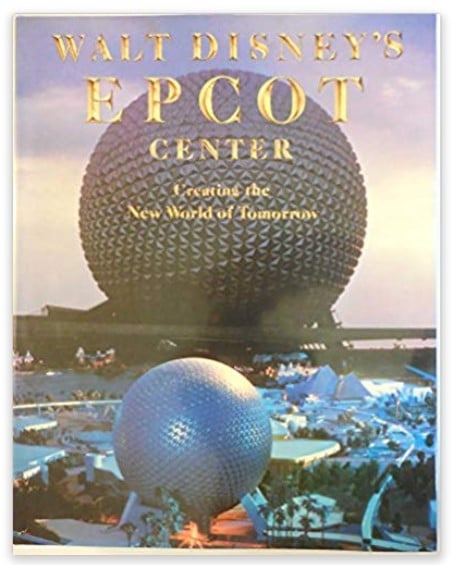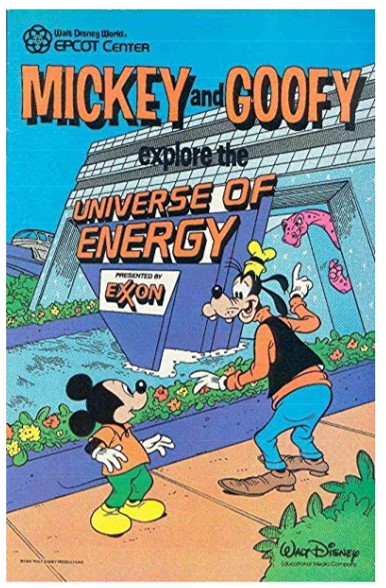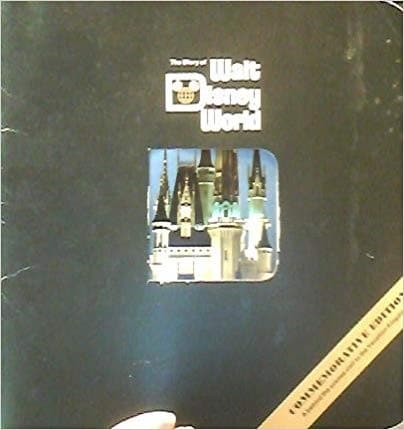Category — A Friday Visit with Jim Korkis
A Friday Visit with Jim Korkis: Walt Disney’s EPCOT Center
Welcome back to Fridays with Jim Korkis! Jim, the dean of Disney historians, writes about Walt Disney World history every Friday on yourfirstvisit.net.
YOUR PERSONAL DISNEY LIBRARY (24)
By Jim Korkis
- Walt Disney’s EPCOT Center: Creating the New World of Tomorrow by Richard Beard
While there have been many impressive recent books about Walt Disney World, it is also important to consider adding some older editions to your personal Disney library.
Walt Disney’s EPCOT Center: Creating the New World of Tomorrow is historically fascinating and still valued by Disney fans for its text and illustrations, despite much of the information being outdated by all the changes that have taken place over the decades. It really is a time capsule for a park that no longer exists and will disappear even more with the new changes that have been recently announced.
Published by Harry Abrams Inc. in New York, it had the full approval and cooperation of the Walt Disney Company. Originally written just before Epcot opened so it could encourage guests to visit Disney’s newest theme park, it was hugely popular.
The earliest edition features beautiful concept art that was replaced with color photos in the second edition. In fact, the book resembles the high-end art books being produced by Harry Abrams Inc. at the time, including even fold-out pages for some of the illustrations.
There are four distinct versions of the book.
The first edition was simply called Walt Disney’s Epcot. The second edition after the park opened was entitled Walt Disney’s Epcot Center with the addition of the five interlocking circles logo and the official Epcot Center lettering on the front cover.
Both editions are huge, roughly 9.5 inches wide and 12 inches tall and 239 pages long. Other than changing some of the concept art and models for photographs of the finished park, the text and the layout remains pretty much the same in the second edition.
The book traces the design and construction of the park but avoids discussing why Walt’s original dream failed to materialize. The wonderful artwork and photos make the book a priceless addition to a collection especially for a fan of Epcot.
Two other smaller, thinner editions were issued that measure roughly less than 9 inches wide and 11 inches tall and contain only 127 pages. They have a stiff board cover rather than the dust jackets on the two larger editions.
These smaller versions were less expensive and meant to be sold as a souvenir edition at the Disney theme parks. Like the larger editions, one was published just as the park was opening and the other had updated photographs after the park had opened.
I point out these differences because it is important to know which edition you are purchasing. I have all four editions so that I can use them for reference when I write my articles and books, but you may just want one of them to add to your collection.
The larger volumes have an almost twenty page introduction by Marty Sklar that is trimmed to roughly four pages in the smaller editions. When I talk about concept art, it is not just the paintings shown in the American Adventure section or Bob McCall’s paintings for Horizons, but material like three pages of artwork for Japan’s Meet the World attraction that never opened at Epcot.
Unlike some other older books, this is not a difficult or expensive book to obtain. I definitely wish similar volumes had been produced for the other Disney theme parks, but it is great that this one was.
* * * * *
Thanks, Jim! And come back next Friday for more from Jim Korkis!
In the meantime, check out his books, including his latest, Disney Never Lands, and about planned but unbuilt concepts, and Secret Stories of Walt Disney World: Things You Never You Never Knew, which reprints much material first written for this site, all published by Theme Park Press.
Follow yourfirstvisit.net on Facebook or Twitter or Pinterest!!
December 27, 2019 No Comments
A Friday Visit with Jim Korkis: Disney Springs and its Stories
Welcome back to Fridays with Jim Korkis! Jim, the dean of Disney historians, writes about Walt Disney World history every Friday on yourfirstvisit.net.
DISNEY SPRINGS AND ITS STORIES
By Jim Korkis
Florida has one of the largest concentrations of freshwater springs on Earth, with more than 900 natural springs. Springs served as locations for Spanish missions, steamboat landings, gristmills and more, including reservoirs for irrigating crops. A few springs gave birth to towns, including Silver Springs in Marion County, Green Cove Spring in Clay County, and De Leon Springs in Volusia County.
Inspired by small Florida towns that developed in the early 1900s around these bodies of water, the storyline for Disney Springs–the shopping, dining and entertainment area of the far east side of Walt Disney World–is that Disney Springs also attracted its first settlers “more than a century ago”.
That original group of settlers discovered a natural spring and a wonderful piece of land near it to settle on in the mid-1800s. They built the Town Center where the residents lived. They even built a water side promenade where they could gather to relax after a busy day.
As the population grew, the town branched out to towards the water with The Landing, which was the transportation hub (for planes, trains and more), and then continued to expand, on either side of the Town Center, with the Marketplace and the West Side.
In the West Side there are remnants of an elevated train trestle that was supposedly built for the fictional 1950 Springs Centennial Expo that is shown on a poster in D-Luxe Burger and at Guest Relations. That Expo had hot air balloons and a big distinctive central structure like most World’s Fairs that later became Characters in Flight and the Cirque du Soleil building.
According to the back story, a Florida cattle rancher named Martin Sinclair and his wife Clara first discovered the water source of the Springs in 1850 and settled there. Sinclair shifted from just being a dealer in beef cattle after he attended the St. Louis World’s Fair and discovered a new treat: a hamburger.
That inspiration resulted in the Glowing Oak Ranch evolving into a small family restaurant. Glowing Oak Ranch became Glowing Oak Restaurant officially on July 24, 1921. The restaurant provided the refreshments for the Springs Grand Centennial Expo in 1950.
Officially, the “current owner, Martin Sinclair VI” re-branded the Glowing Oak Restaurant to D-Luxe Burger on May 15, 2016.
Blaze Pizza took over the space in Town Center at Disney Springs that used to be occupied by the town’s lumber mill – The Buena Vista Timber Company established in 1868.
The restaurant design includes elements reminiscent of the workings of a sawmill, from a prop wood planer to the layout of the dining room where the tables and benches are arranged in rows to suggest logs that have been pulled up to the mill from the springs.
The Ganachery Chocolate Shop used to house the town’s only apothecary shop that supplied the necessary medicines for the inhabitants to cure their ills.
The space was taken over by a South American couple (their photos are on the wall) who turned their love for the cocoa bean, a major South American crop from which chocolate is made, into a chocolate shop adapting the existing pharmacy shelves and equipment to their needs.
An old billboard advertises the passenger train that used to stop in the town. There are some stray rails still embedded in the pathways. STK Steakhouse is the home of the old railroad station and is a reference to a 1889 train station in Downtown Orlando. The Imagineers didn’t need to reference old photos because the station still stands today. It’s Church Street Station.
The Polite Pig was the location of the original farmer’s market for the area. Ancient machinery sits unused next to a weathered sign, which indicates that the apparatus was used for a spring water ice works operation that now houses Sprinkles. The bottling plant was a building reclaimed to house Morimoto Asia.
Many more stories behind the various buildings were created by Imagineers and are awaiting to be rediscovered.
* * * * *
Thanks, Jim! I don’t much cover Disney Springs on this site, but our book is rich in overviews and dining reviews. See below for how we start.
And come back next Friday for more from Jim Korkis!
In the meantime, check out his books, including his latest, Disney Never Lands, and about planned but unbuilt concepts, and Secret Stories of Walt Disney World: Things You Never You Never Knew, which reprints much material first written for this site, all published by Theme Park Press.
Follow yourfirstvisit.net on Facebook or Twitter or Pinterest!!
December 20, 2019 No Comments
A Friday Visit with Jim Korkis: An Epcot Comic Book with Mickey and Goofy
Welcome back to Fridays with Jim Korkis! Jim, the dean of Disney historians, writes about Walt Disney World history every Friday on yourfirstvisit.net.
MICKEY AND GOOFY EXPLORE THE UNIVERSE OF ENERGY
By Jim Korkis
Mickey Mouse and Goofy certainly were very concerned about energy. Thanks to the Walt Disney Educational Media Company, they were able to satisfy their curiosity and appeared in an unusual early Epcot Center collectible.
Starting in 1945, the Disney Company established an official 16mm film division to rent out its movies to schools and community groups. By the 1960s, the division was making well over a million dollars a year renting films and selling educational filmstrips and related material to schools, and expanded into the Walt Disney Educational Media Company that was especially active during the 1970s and 1980s.
The division produced original material ranging from filmstrips to comic books to kits with audio cassettes and workbooks, to even short new videos on a variety of subjects including Figment for elementary and junior high schools. For instance, WDEM created the thirty-six page full color comic book Mickey Mouse and Goofy Explore Energy (1967) included in its Wide World of Energy multimedia kit made with information assistance from Exxon.
The popularity of that comic and kit led to another comic book Mickey Mouse and Goofy Explore Energy Conservation (1976). Both comic books were written by Carl Fallberg and drawn by Tony Strobl, who were also producing the regular newsstand Disney comic books. Both these comics were available “in limited quantities without charge” from the Exxon Public Affairs Department in Texas, so they are not difficult to locate and obtain at a reasonable price.
When the Universe of Energy pavilion originally opened at Epcot in 1982 it was sponsored by Exxon, who made sure the attraction downplayed the value of alternative forms of energy like wind and solar power.
To help reinforce the proposition that oil was the most important source of energy, and that Exxon should be actively encouraged to develop methods like off-shore drilling to make sure there would be enough, the company partnered with Walt Disney Educational Media to produce the comic book Mickey and Goofy Explore the Universe of Energy (1985).
This comic was illustrated by Jack Manning, another Disney comic book artist, and was sixteen pages long plus covers. For awhile, it was given away free at the Epcot Energy Exchange in Communicore East to children. It could also be obtained for free directly from Exxon.
The cover features Mickey and Goofy standing in front of the pavilion and a pink dinosaur is peeking out and motioning them to come inside. The book itself does not really feature the attraction itself but is just a springboard for Mickey to lecture Goofy on the importance of oil as the primary source of energy.
There is a brief glimpse of the pre-show circular theater screen, the vehicles (where all the males are wearing bow ties and hats as if they had stepped out of a 1950s comic book), a brief encounter with a cartoon brontosaurus and at the end a prompting for guests to go to Exxon’s Energy Exhange to learn more.
The Energy Exchange (which closed in 1994) had dozens of interactive exhibits, videos, models and more on energy. The Video Bicycle allowed guests to pedal a stationary bicycle to generate electricity. A video monitor displayed how much power the guest was generating through their pedaling. (Nine days of pedaling was needed to generate the same amount of energy as one gallon of gasoline.) How many Walt Disney World fans recall that location?
* * * * *
Thanks, Jim! And come back next Friday for more from Jim Korkis!
In the meantime, check out his books, including his latest, Disney Never Lands, and about planned but unbuilt concepts, and Secret Stories of Walt Disney World: Things You Never You Never Knew, which reprints much material first written for this site, all published by Theme Park Press.
Follow yourfirstvisit.net on Facebook or Twitter or Pinterest!!
December 13, 2019 No Comments
A Friday Visit with Jim Korkis: Fantasmic!
Welcome back to Fridays with Jim Korkis! Jim, the dean of Disney historians, writes about Walt Disney World history every Friday on yourfirstvisit.net.
FANTASMIC AT DISNEY’S HOLLYWOOD STUDIOS
By Jim Korkis
The origins of Fantasmic! go back to September 1990 when Robert McTyre, vice president of Disneyland Entertainment, got a phone call from CEO Michael Eisner.
McTyre recalled, “He said, ‘We don’t have anything big and new and fabulous for Disneyland in 1992 and we need to come up with something’. Basically, it was an interim step to keep interest in Disneyland high before the 1993 addition of Mickey’s Toontown. We got the troops brainstorming and someone suggested a nighttime river spectacular like the IllumiNations show at Epcot.”

She went on to direct and choreograph the original Disneyland’s Main Street Electrical Parade in 1972, as well as multiple other shows for Disneyland, Walt Disney World and other venues including the 1985 Radio City Music Hall presentation with 82 Disney characters and the Rockettes.
In August 2019, she was made a Disney Legend at the D23 Expo. She retired from the company in 2013 after forty years working in a variety of capacities.
“We were asked to create something spectacular for Disney using the Rivers of America,” Ricci said. “We wanted something truly unique that combined a lot of spectacular effects that people hadn’t seen before and with a story about Mickey Mouse that would really involve people.
“The core for the show was the water screens. It would be unique to project Disney animation onto one of those screens. Mickey Mouse’s imagination creates these images and the audience gets involved with Mickey. We were given only twenty months, far too little time.
“I spent months of research studying all the Disney classics. I wanted to find just the right scenes that could be edited together successfully. One challenge was that the new lyrics had to match the mouth movements of the original animation in which characters were often saying far different lines. Originally the show was going to be called Imagination but Disney found it couldn’t copyright or trademark that word so created its own unique word.
“Particularly challenging were synchronizing the movements of the performers with the computer controlled animation and special effects. It’s timed to the 30th of a second (the number of frames per second of the films being projected) and if things are two frames off, you can tell. They must be exactly on.”
The show was so successful that a second version was developed for Walt Disney World for 1998 with Ricci once again in charge. The Disney animated feature Pocahontas was released in 1995 and was supposed to be a prestige box office hit.
While it was very successful financially, it was still considered a disappointment in comparison to The Lion King (1994) that had been rushed into release to allow the better animators more time to finish Pocahontas.
At the time the WDW version of Fantasmic! was first developed, the expectation was that Pocahontas would be a major success, which influenced the design of the show. An onstage battle scene from the movie has Governor Ratcliffe and his fellow Englishmen fight against the Native Americans. John Smith attempts to help Pocahontas’ tribe.
There are several other significant changes in the Walt Disney World version, including the finale with the boat from Steamboat Willie loaded with Disney characters rather than the Mark Twain steamboat.
The Hollywood Hills Amphitheater stage in Florida is significantly larger than Disneyland’s waterfront version, featuring a man-made, 50-foot-tall mountain as the centerpiece backdrop. The moat around the island itself can hold 1,900,000 gallons of water.
* * * * *
Thanks, Jim! And come back next Friday for more from Jim Korkis!
In the meantime, check out his books, including his latest, Disney Never Lands, and about planned but unbuilt concepts, and Secret Stories of Walt Disney World: Things You Never You Never Knew, which reprints much material first written for this site, all published by Theme Park Press.
Follow yourfirstvisit.net on Facebook or Twitter or Pinterest!!
December 6, 2019 No Comments
A Friday Visit with Jim Korkis: The Fort Wilderness Alligator Attack
Welcome back to Fridays with Jim Korkis! Jim, the dean of Disney historians, writes about Walt Disney World history every Friday on yourfirstvisit.net.
THE 1986 FORT WILDERNESS ALLIGATOR ATTACK
By Jim Korkis
In 1986, eight-year-old Paul Santamaria was bitten on the leg by a 7-foot-4 inch long female alligator, which had been lurking in the shallows of a pond at Fort Wilderness Resort and Campground.
Santamaria now lives in Hebron, New Hampshire and was interviewed by a local ABC affiliate when two year old Lane Graves was taken by an alligator in 2016.
“It was pretty terrifying at the time,” said Santamaira. “Under the water, where you couldn’t see, there was an alligator.”
Santamaria had been watching ducks waddling out of a small pond, located on the grounds of the resort, when he was snatched up by the sharp-toothed creature.
Fortunately for him, his 12-year-old sister and 10-year-old brother were there to save his life.
“Instead of just freezing, they decided to fight, to help me to fight to get away, and I’m here because of it,” Santamaria recalled.
“It came out of the water, knocked me down, grabbed my leg and started to throw me around and try to pull me into the water. My sister grabbed me under the arms and started pulling me away from the alligator. My brother started hitting it with whatever he could find and trying to get it to let me go, and with my free leg, I started to kick it and try to get away from it.”
While he managed to escape with his life, he was left with large gashes in his leg and a gator tooth lodged in his thigh.
“I was very lucky,” he said. “I still have some scars on my left leg, but that’s it.”
Santamaria said that while he felt even more fortunate after hearing about what happened to Lane Graves in 2016, it hurt to know that someone had lost their child.
Santamaria, who has been back to Disney World at least three times since the attack said that while it would be wise for Disney to have signs that warn of alligators, people need to remember one thing: that creatures like alligators are commonly found in Florida and small children usually can’t read very well.
“It’s hard to say what can and can’t be done,” he explained. “I don’t want to paint this as Disney is wrong or the parents are wrong. All I know is that as a child, at eight-years-old, there could have been signs there and I wouldn’t have noticed them.
“Children can’t read signs or just don’t pay attention to them. And parents who are trying to watch their kids might not notice those signs, either. They could have all the signage in the world there, and people could still not notice it.
“While attacks are rare, they do happen, and people who live up north don’t even think about the possible danger. While it won’t affect my decision for bringing my children to Walt Disney World in the future, it will definitely have me more alert of the surroundings.
“My kids love their movies, and I even plan on taking them back in the next year or so. It’s a place that families love to go. I look forward to taking my children there. With my situation, I was more fortunate than this (Graves) family was, so their feelings might be different.”
* * * * *
Thanks, Jim! And come back next Friday for more from Jim Korkis!
In the meantime, check out his books, including his latest, Disney Never Lands, and about planned but unbuilt concepts, and Secret Stories of Walt Disney World: Things You Never You Never Knew, which reprints much material first written for this site, all published by Theme Park Press.
Follow yourfirstvisit.net on Facebook or Twitter or Pinterest!!
November 29, 2019 No Comments
A Friday Visit with Jim Korkis: The Story of Walt Disney World
Welcome back to Fridays with Jim Korkis! Jim, the dean of Disney historians, writes about Walt Disney World history every Friday on yourfirstvisit.net.
YOUR PERSONAL DISNEY LIBRARY (23)
By Jim Korkis
- The Story of Walt Disney World Commemorative Edition
New books related to Walt Disney World seem to be published almost every month these days, but when the new vacation destination first opened in 1971 there was almost nothing. Steve Birnbaum Brings You The Best of Walt Disney World did not appear until 1982, with the Disneyland edition not being issued until 1985.
Of course in 1971, there was the park’s souvenir guide that was primarily filled with colorful photos and there were magazine articles but only one bookish publication: The Story of Walt Disney World Commemorative Edition.
This oversized eleven inches by eleven inches softcover publication was 48 pages long plus covers, and only sold at WDW. The right edge was trimmed so that the cover looked like a big black letter “D” with a “D” cut-out window in the center that showed part of a color night-time photograph of Cinderella Castle that filled most of the first page on the book. The rest of that page was a reprinting of the text of the famous dedication plaque.
The book is indeed filled with lots of color photographs, some never reprinted and many showing the actual construction of WDW, but more importantly this publication includes some significant text rather than just brief picture captions.
The book was available in 1971–but collectors, be very careful. It remained in print throughout the 1970s, but each reprinting still included the yellow slanted “Commemorative Edition” banner in the lower right hand corner. As a result, many sellers offer this book at a higher price and advertise it as a first printing, when in fact it may be a later edition.
In my own collection, I also have editions from 1973 and 1978. How do I know? Because the copyright date is printed in Roman numerals at the bottom right of the inside front cover. To the best of my knowledge, this booklet was no longer published beginning in 1980.
In addition, the first edition featured the well-remembered Paul Hartley map of WDW that was displayed in the WDW hotel resort rooms. Starting in 1973, that map was replaced by a different, cartoony map that featured the newly opened Golf Resort hotel on the lower left hand side.
Also the map now included cartoonish drawings of guests enjoying all of the Walt Disney World property, along with Disney cartoon characters like Uncle Scrooge welcoming motorists at the entrance, Goofy in Scottish attire strolling a golf course and an oversized Mickey Mouse signing autographs for a family outside of the Magic Kingdom. Later editions add Space Mountain and the Fort Wilderness Resort railroad.
So when purchasing a copy, remember that the book is quite common since it was one of the primary souvenirs that guests would purchase for roughly a decade, and take into account which edition you are purchasing. Just because something is old does not necessarily make it rare or more valuable.
Interestingly, the text of the book remained much the same throughout the different editions because it was generally historical in nature even though some of the photos changed as changes were made to the area.
Think of the book as an enjoyable time capsule of what the “world” once was. It may bring back fond memories for those who were there at the time, or spark the curiosity of those who wonder about those photos of cutting the tiles for the Cinderella Castle mural or programming the audio-animatronics for the Mickey Mouse Revue.
* * * * *
Thanks, Jim! And come back next Friday for more from Jim Korkis!
In the meantime, check out his books, including his latest, Disney Never Lands, and about planned but unbuilt concepts, and Secret Stories of Walt Disney World: Things You Never You Never Knew, which reprints much material first written for this site, all published by Theme Park Press.
Follow yourfirstvisit.net on Facebook or Twitter or Pinterest!!
November 22, 2019 No Comments







